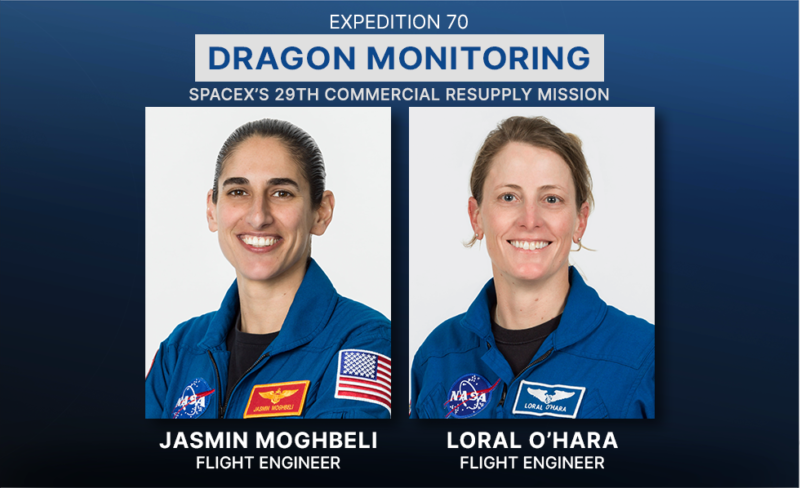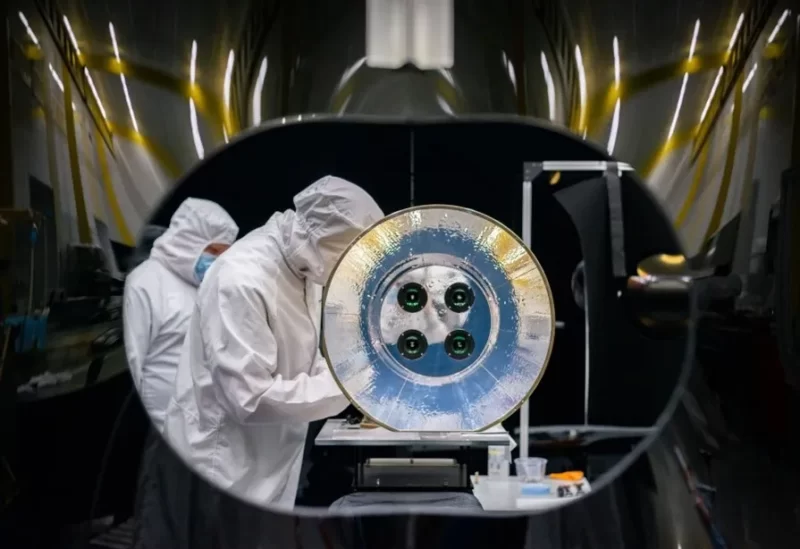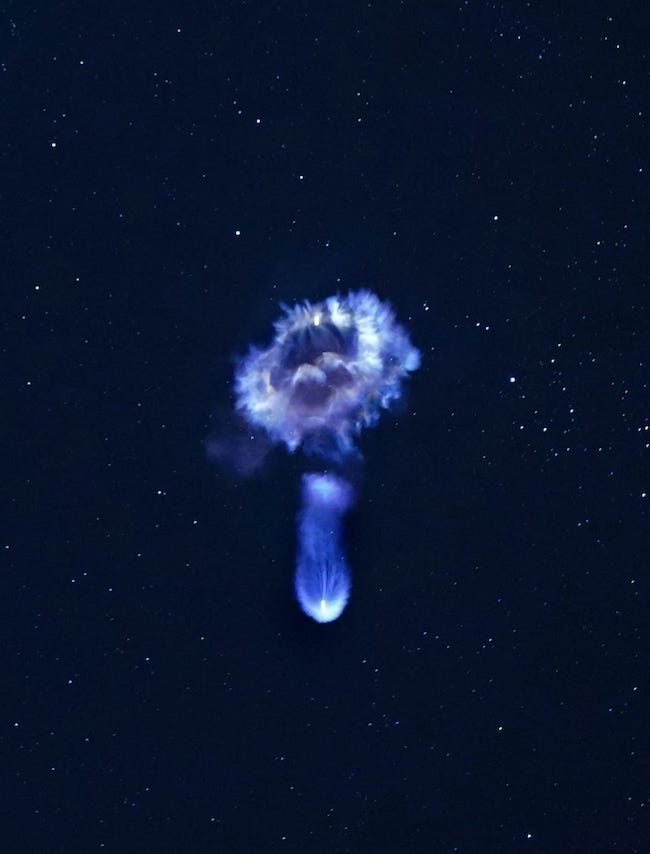
The 2024 lunar calendars are here! Best Christmas gifts in the universe! Check ’em out here.
CRS-29: SpaceX resupply mission to the ISS
SpaceX successfully launched its 29th cargo mission to the International Space Station (ISS) on Thursday, November 9, 2023. The CRS-29 mission lifted off atop a Falcon 9 rocket from NASA’s Kennedy Space Center in Florida at 8:28 p.m. EST on November 9 (1:28 UTC on November 10). Dragon is to deliver over 6,500 pounds (3,000 kg) of supplies and scientific hardware to the ISS, including seasonal treats like chocolate, pumpkin spice coffee, and cranberry sauce.
NASA astronauts and Expedition 70 Flight Engineers Jasmin Moghbeli and Loral O’Hara will monitor the CRS-29 Dragon capsule’s docking with the ISS on Saturday, November 11. NASA TV will begin its docking coverage at 3:45 a.m. EST (8:45 UTC) on Saturday. The docking itself is scheduled to take place at 5:21 a.m. EST (10:21 UTC).
Watch Dragon dock with the ISS here.

See the launch in the video below
You can watch a recorded livestream of the launch in the video below, or on SpaceX’s X account.
AWE and ILLUMA-T
Among the cargo are two distinguished experiments, AWE (Atmospheric Waves Experiment) and ILLUMA-T (Integrated Laser Communications Relay Demonstration Low Earth Orbit User Modem and Amplifier Terminal). Both are funded by NASA’s Space Communications and Navigation Program.
The AWE experiment seeks to determine the forces driving space weather, challenging the previous belief that only the sun’s solar wind influences the upper atmosphere. Specifically, it will help scientists study airglow patterns. Airglow refers to the faint, predominantly greenish or reddish glow of the Earth’s upper atmosphere, particularly in the night sky.
ILLUMA-T, on the other hand, is poised to revolutionize space communications. The experiment will test high-speed laser communications, working in tandem with NASA’s Laser Communications Relay Demonstration mission. By creating NASA’s first two-way laser communications relay system, ILLUMA-T opens the door to improving how we send data in space, adding to the existing radio systems and preparing scientists for more advanced exploration in outer space.

After CRS-29, more spaceflight to come
After Thursday night’s launch, the Falcon 9’s first stage landed back on Earth at Cape Canaveral Space Force Station’s Landing Zone 1. The November 10 launch marked the 9th flight on the Commercial Resupply Services-2 SpaceX contract and the second flight of this Dragon spacecraft, which previously flew on NASA’s SpaceX 26th resupply services mission. Previously, this Dragon supported the Crew-7 mission.
The ISS is celebrating its 25th anniversary this month. With 273 individuals from 21 countries having visited the ISS, the orbiting laboratory continues to symbolize global collaboration: not a bad message for these trying times.

Bottom line: SpaceX launched its 29th cargo mission to the ISS atop a Falcon 9 rocket from Florida at 8:28 p.m. EST (01:28 UTC on November 10). The cargo is expected to arrive at the ISS at 5:21 a.m. EST (10:21 UTC) on November 11.
Via NASA: NASA’s SpaceX CRS-29 Mission Overview
The post SpaceX CRS-29 Dragon capsule on its way to the ISS first appeared on EarthSky.
from EarthSky https://ift.tt/g8ImDxM

The 2024 lunar calendars are here! Best Christmas gifts in the universe! Check ’em out here.
CRS-29: SpaceX resupply mission to the ISS
SpaceX successfully launched its 29th cargo mission to the International Space Station (ISS) on Thursday, November 9, 2023. The CRS-29 mission lifted off atop a Falcon 9 rocket from NASA’s Kennedy Space Center in Florida at 8:28 p.m. EST on November 9 (1:28 UTC on November 10). Dragon is to deliver over 6,500 pounds (3,000 kg) of supplies and scientific hardware to the ISS, including seasonal treats like chocolate, pumpkin spice coffee, and cranberry sauce.
NASA astronauts and Expedition 70 Flight Engineers Jasmin Moghbeli and Loral O’Hara will monitor the CRS-29 Dragon capsule’s docking with the ISS on Saturday, November 11. NASA TV will begin its docking coverage at 3:45 a.m. EST (8:45 UTC) on Saturday. The docking itself is scheduled to take place at 5:21 a.m. EST (10:21 UTC).
Watch Dragon dock with the ISS here.

See the launch in the video below
You can watch a recorded livestream of the launch in the video below, or on SpaceX’s X account.
AWE and ILLUMA-T
Among the cargo are two distinguished experiments, AWE (Atmospheric Waves Experiment) and ILLUMA-T (Integrated Laser Communications Relay Demonstration Low Earth Orbit User Modem and Amplifier Terminal). Both are funded by NASA’s Space Communications and Navigation Program.
The AWE experiment seeks to determine the forces driving space weather, challenging the previous belief that only the sun’s solar wind influences the upper atmosphere. Specifically, it will help scientists study airglow patterns. Airglow refers to the faint, predominantly greenish or reddish glow of the Earth’s upper atmosphere, particularly in the night sky.
ILLUMA-T, on the other hand, is poised to revolutionize space communications. The experiment will test high-speed laser communications, working in tandem with NASA’s Laser Communications Relay Demonstration mission. By creating NASA’s first two-way laser communications relay system, ILLUMA-T opens the door to improving how we send data in space, adding to the existing radio systems and preparing scientists for more advanced exploration in outer space.

After CRS-29, more spaceflight to come
After Thursday night’s launch, the Falcon 9’s first stage landed back on Earth at Cape Canaveral Space Force Station’s Landing Zone 1. The November 10 launch marked the 9th flight on the Commercial Resupply Services-2 SpaceX contract and the second flight of this Dragon spacecraft, which previously flew on NASA’s SpaceX 26th resupply services mission. Previously, this Dragon supported the Crew-7 mission.
The ISS is celebrating its 25th anniversary this month. With 273 individuals from 21 countries having visited the ISS, the orbiting laboratory continues to symbolize global collaboration: not a bad message for these trying times.

Bottom line: SpaceX launched its 29th cargo mission to the ISS atop a Falcon 9 rocket from Florida at 8:28 p.m. EST (01:28 UTC on November 10). The cargo is expected to arrive at the ISS at 5:21 a.m. EST (10:21 UTC) on November 11.
Via NASA: NASA’s SpaceX CRS-29 Mission Overview
The post SpaceX CRS-29 Dragon capsule on its way to the ISS first appeared on EarthSky.
from EarthSky https://ift.tt/g8ImDxM

Aucun commentaire:
Enregistrer un commentaire